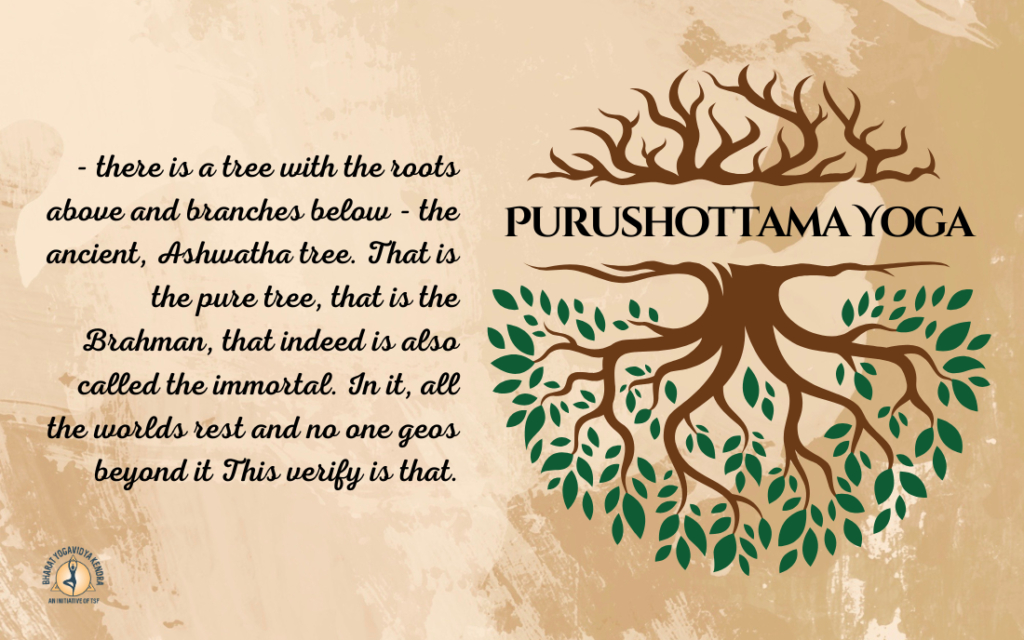
The 15th chapter of the Bhagavad Gita titled Purushottama Yoga, is a sublime masterpiece of spiritual philosophy. Lord Krishna, the eternal teacher, in this relatively short chapter, reveals the essence of the Supreme Being (Purushottama) and provides us with a spiritual roadmap to liberation. For a sadhaka, this chapter is not just a guide and a mirror.
The Cosmic Tree of Life
Lord Krishna begins with the striking imagery of the Tree of Life—a mystical tree with its roots above and branches below. This tree symbolizes Samsara, the endless cycle of birth, death, and rebirth. Its branches represent desires, attachments, and the entanglements of worldly life. Krishna explains that this tree has no beginning or end, and its perplexing nature can be understood only by one equipped with detachment and discrimination.
To sever this tree, Krishna advises wielding the “axe” of detachment. This act represents a seeker’s ability to cut through illusions and worldly attachments, recognizing the fleeting nature of material existence. For the sadhaka, the tree serves as a reminder of the need to look beyond appearances and search for the eternal.
The Journey from Jiva to Paramatma
Krishna then takes us deeper, explaining the threefold reality:
- Jagat: The transient, ever-changing world.
- Jiva: The individual soul trapped in Samsara.
- Paramatma: The Supreme Being, the eternal witness residing in all.
The chapter emphasizes that the goal of a seeker is to transcend the Jagat and realize the Paramatma. Through devotion, detachment, and clarity of purpose, the sadhaka can bridge the gap between the individual soul and the Supreme soul.
The Supreme as Sustainer
One of the most poetic and awe-inspiring aspects of this chapter is Krishna’s description of how the Divine sustains life. He identifies Himself as the Vaishvanara, the digestive fire within every being, responsible for metabolizing the four types of food we consume. He speaks of the partnership between Prana (life energy) and this fire, reminding us that even the simple act of eating is made possible by the Divine’s grace.
This intimate connection between the Lord and our physical sustenance deepens the sadhaka’s devotion. It transforms ordinary acts into opportunities for gratitude and mindfulness, reminding us that the Divine operates not only in grand cosmic events but in the small, essential rhythms of daily life.
Why Chant Purushottama Yoga?
For a sadhaka, chanting this chapter is a powerful spiritual practice. The vibrations of its verses carry the essence of Krishna’s teachings, awakening the seeker’s inner awareness. Chanting helps internalize the ideas of detachment, discrimination, and devotion, while also purifying the mind.
Moreover, the chapter serves as a meditative tool, guiding the sadhaka to contemplate the unity of existence:
- The Divine expressed as the force of nature (Adi Daivik).
- The Divine as the individual self (Adhyatmik).
- The Divine as the material reality (Adi Bhautik).
When chanted with faith and understanding, these verses awaken a higher vision, allowing the seeker to experience the Supreme within and around them.
Seeing the Divine Everywhere
Krishna urges us to see Him in everything: in the sun, the moon, the fire, and the hearts of all beings. He is the knower, the known, and the means of knowledge itself. By meditating on this truth, the sadhaka eliminates all perceived differences and sees the Divine in every person, object, and situation.
This vision is not abstract—it transforms how we live. By seeing divinity in the mundane, we develop gratitude, compassion, and a sense of connection with the universe.
Learn Purushottama Yoga

Listen to BYK’s video on Purushottama Yoga to learn the verse by verse meaning. For those ready to fully immerse themselves, the Purushottama Yoga Chanting Retreat at MahaKumbh offers a rare opportunity to learn the chapter, reflect, and meditate on Purushottama.
